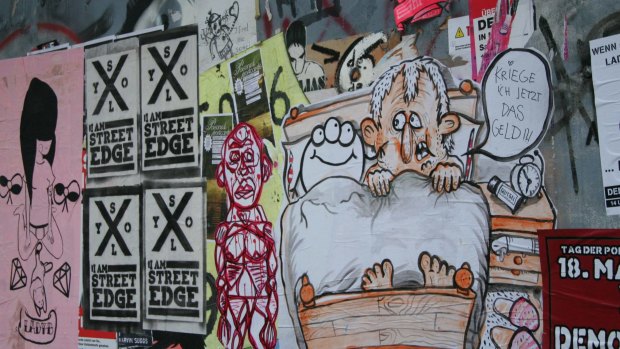
Visitors can explore the best street art sites with Alternative Berlin Tours.Credit: Visit Berlin
1 THE FALL OF THE WALL…
When the Berlin Wall came down in 1989, it left a giant empty swath through the centre of the city. Artists and squatters moved into abandoned buildings, creating temporary work and play spaces. By the time the developers could take over the prime real estate, an edgy cultural scene was well and truly established. The best place to see what's left of the Wall is Bernauer Strasse.
2 ...AND WHAT REPLACED IT
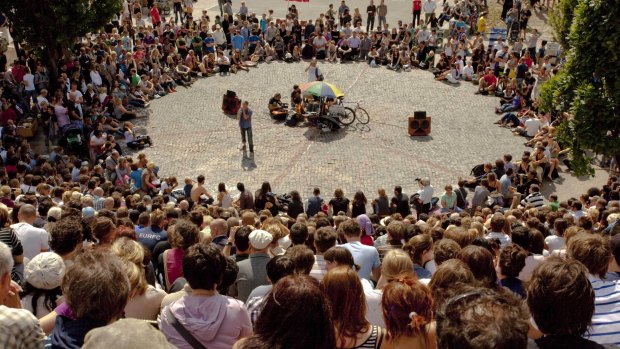
Bearpit Karaoke takes place every Sunday afternoon, with wannabes at the mercy of the large crowds.Credit: Visit Berlin
Big shiny developments such as the Potsdamerplatz shopping and entertainment centre have popped up along the path of the wall. But it's the more absurd additions that give Berlin its character, such as the mini-amphitheatre in the Mauerpark where the thousand-strong audience gathers for Bearpit Karaoke every Sunday afternoon. Or the sprawling artificial beach bars, like BeachMitte with its numerous volleyball courts. See bearpitkaraoke.com, beachberlin.de/beachmitte.
3 WORLD WAR II HISTORY
Berlin's role in World War II was anything but cool, but it was undeniably fascinating. The Topography of Terror Documentation Centre is on the site of former Gestapo and SS buildings, and takes a museum-like delve into the horrors of the Nazi regime, covering everything from propaganda to ghettos. The abstract, thought-provoking Holocaust Memorial is a huge landmark too. See topographie.de.
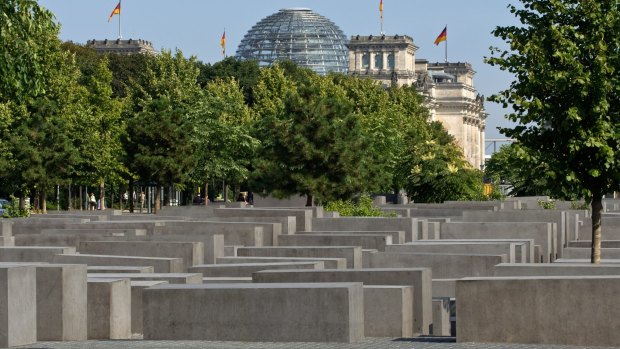
The confronting Memorial to the Murdered Jews of Europe addresses the city's dark past.
4 THE AMERICAN INFLUENCE
After World War II, Berlin was divided up into four zones, and the Americans left the biggest influence. The likes of David Bowie and Iggy Pop moved into the American quarter, JFK gave his "Ich bin ein Berliner" speech at the Schoneberg town hall and plenty of classic cars were left behind. Mustang Safari offers self-drive tours of the American quarter in a vintage Mustang. See mustang-safari.de.
5 ANTI-SURVEILLANCE ATTITUDE
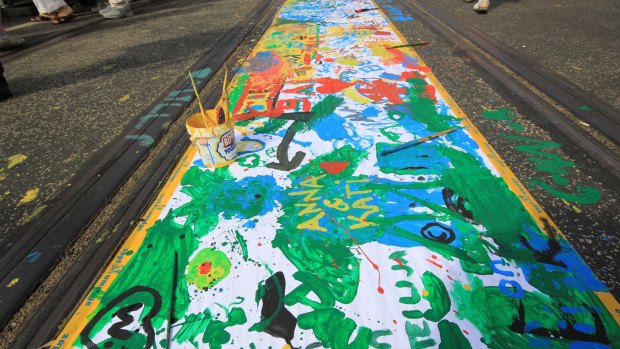
Street art is huge in the city thanks to a relative absence of CCTVs.Credit: Visit Berlin
After living under the authoritarian, communist GDR state with an all-pervading secret police, Berlin's residents were severely antagonistic towards being monitored. So Berlin has very few security cameras in comparison with most major cities – and that has allowed first graffiti taggers and then street artists to thrive. The result? It's one of the world's greatest cities for street art, and Alternative Berlin Tours runs tours around the best work. See alternativeberlin.com.
6 GDR NOSTALGIA
Life in the GDR isn't seen as all bad, though, and a heady wave of nostalgia for it adds a quirky edge to the city. This is most obviously seen the jaunty Ampelmann pedestrian crossing character. The latter has become a ubiquitous emblem, having shops and restaurants devoted to him. There's also the DDR Museum which delves into everything East German – from nude beaches to scratchy, horrible denim. See ddr-museum.de.
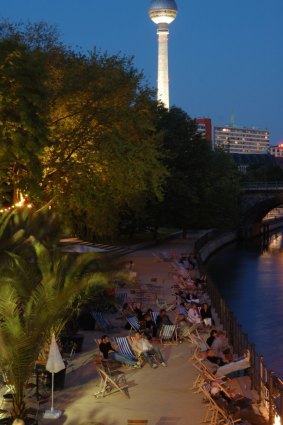
The Beach bar shows Berliners know how to have fun.Credit: Visit Berlin
7 LOW LIVING COSTS
Compared with other major European capitals, Berlin is a bargain for housing, food and general going-out costs. It's not dirt cheap, but you'll rarely worry about prices there. And for travellers, affordable housing also translates into affordable hotels. For example, you can find rooms at the five-star Sofitel Berlin Kurfürstendamm in the peak summer season for from $168 a night. See sofitel-berlin-kurfuerstendamm.com.
8 INTERNATIONAL FLAVOUR
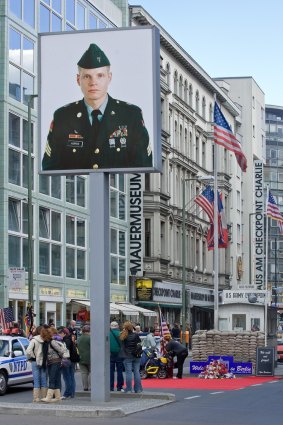
Checkpoint Charlie, which became synonymous with the fall of communism.
Those low costs are a major factor in bringing people from all over the world into Berlin. It's by far the least German city in Germany, tour guides are often Irish, American or Australian and you're as likely to hear English being spoken as German. Fat Tire Bike Tours is a good example of a tour company using fun-loving guides from around the globe. See berlin.fattirebiketours.com.
9 TURKISH IMMIGRATION
During the '60s and '70s large amounts of Turks were brought in as guest workers, then stayed. Many settled in Kreuzberg and Neukolln, which were down-at-heel for a long time, and ripe for the artists to move into when rents in Mitte and Prenzlauer Berg got too high. They now have a buzzing multicultural vibe, and tremendous kebab shops. Vive Berlin runs focused walking tours of Kreuzberg. See viveberlin.de.
10 TEMPLEHOF
Few places sum up the Berlin attitude more than the old Templehof Airport. It has the history – the Berlin Airlift took place from here – and the quirk factor. Its maze-like architecture has been used as a filming location for the Hunger Games films, while the runway is now a massive park that Berliners have refused to let developers get their hands on. See thf-berlin.de.
The writer was a guest of Visit Berlin (visitberlin.de).
Sign up for the Traveller Deals newsletter
Get exclusive travel deals delivered straight to your inbox. Sign up now.